|
The body of photometric and astrometric data on
stars in the Milky Way Galaxy has been growing very fast in recent
years (Hipparcos/Tycho, OGLE-3, 2-Mass, DENIS, UCAC2, SDSS, RAVE, Pan
Starrs, Hermes, ...) and at the time of the General Assembly the launch
of ESA’s Gaia mission, which will measure astrometric data of
unprecedented precision for ~ 109 stars, will be less than
three years away. On account of our position within the Galaxy and the
complex observational biases that are built into most catalogues,
dynamical models of the Galaxy are a prerequisite full exploitation of
these catalogues. On account of the enormous detail in which we can
observe the Galaxy, models of great sophistication are required.
Moreover, in addition to models we require algorithms for observing
them with the same errors and biases as occur in real observational
programs, and statistical algorithms for determining the extent to
which a model is compatible with a given body of data.
Progress in our understanding of the Milky Way
will be unnecessarily delayed if techniques for constructing dynamical
models are not developed to the level required for modelling Gaia data
before a preliminary version of the Gaia catalogue is released.
Producing models and fitting them to the available data will involve
complex software. It is clearly in the interests of the astronomical
community that these costly tools be developed collaboratively in
modular form. In particular it is desirable that most tasks can be
accomplished by independently developed modules whose performance can
be critically compared at di erent institutions. For this to be
possible, standard interfaces between modules will have to be defined.
JD5 will review status of the different modelling
techniques that might be used, and what will be required to extract our
science goals from the data that will be on hand when the Gaia
Catalogue becomes available. It would also consider the steps that
should be taken to identify tasks and define interfaces.
Producing models of the Milky Way that combine
dynamics and stellar evolution theory with the immense catalogues that
will be available by 2015 is an enormous undertaking that will require
the participation of astronomers from all over the World with expertise
in almost every area of astronomy. The General Assembly of the IAU
provides an opportunity for enthusiasts to get together and think about
what can be done, and how to do it. We already have a formidable body
of observational data to work with, and just six years before a
preliminary version of the Gaia Catalogue should appear. So at JD5 we
should consider what needs to be done, and set up international
collaborations that have the expertise and technical resources to get
the job done.
Contacts:
E-mail: binney@thphys.ox.ac.uk
|
